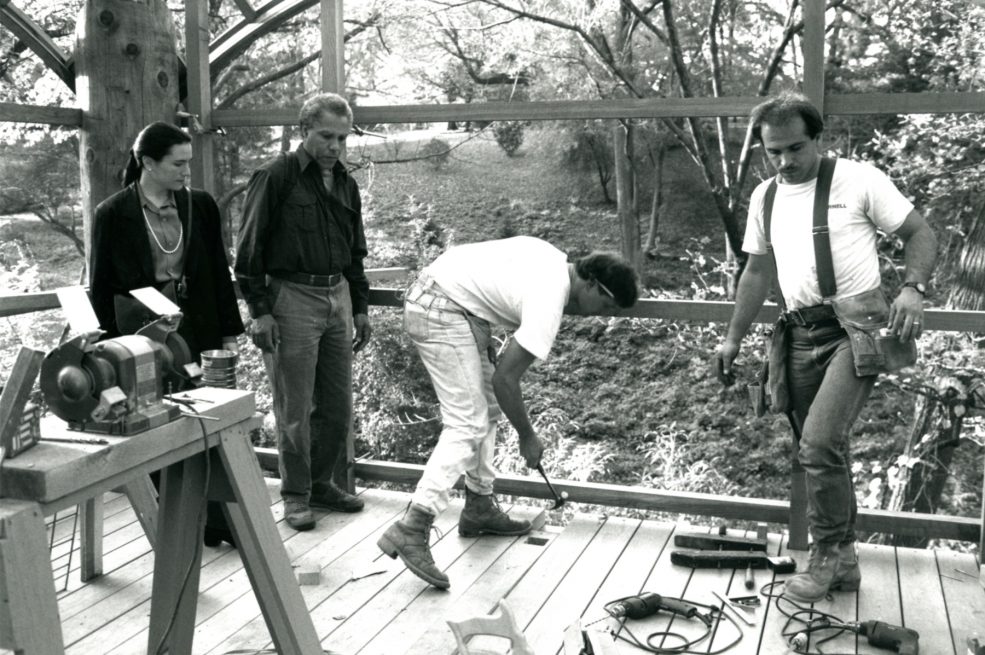At A Glance
PLEASE NOTE: Due to structural safety issues, Pavilion in the Trees is closed to the public until further notice. The Association for Public Art, along with an engineering firm and the Conservation Team at Fairmount Park Conservancy, are working to assess what needs to be done in order to stabilize the structure and reopen it to the public. You can still enter the forested area and observe the artwork–you just can’t go on it or under it. Stay tuned for more information.

Martin Puryear’s Pavilion in the Trees is an amenity located near the Horticulture Center in West Fairmount Park. Conceived in 1981, the public artwork was developed as part of the Fairmount Park Art Association’s (now the Association for Public Art) Form and Function program. The original model included a steep set of stairs, but the artist decided to substitute a sloping ramp for aesthetic and safety reasons.
Situated high among the treetops, the work has become a much-favored place to relax and contemplate nature from a bird’s-eye view
Puryear – whose retrospective exhibition was shown at the Philadelphia Museum of Art in 1992 – worked with architect Samuel Harris, at the time with the firm Kieran Timberlake and Harris, to realize the project, which was supported by the Pew Charitable Trusts, the National Endowment for the Arts, and the Pennsylvania Council on the Arts. Inspired by the universal childhood longing for a tree house, Pavilion consists of an open structure supported by a series of posts.
All of the materials – western red cedar, heart white oak, heart redwood – were selected for their natural durability. A sixty-foot walkway leads across a natural basin to an observation platform – a square deck covered by a latticed canopy – that rises twenty-four feet above the ground. Situated high among the treetops, the work has become a much-favored place to relax and contemplate nature from a bird’s-eye view.
Directions by Car: Exit Rt. 76 at Montgomery Drive and continue west toward Belmont Avenue. Turn left at entrance to the Horticulture Center/Japanese House and Garden. Pavilion in the Trees is in the Lansdowne Glen, behind the Horticulture Center.
Voices heard in the Museum Without Walls: AUDIO program: Martin Puryear, the artist who created Pavilion in the Trees, was inspired by his childhood longing for a tree house. He is heard on archival tape courtesy Art 21, Inc. Bob Taylor, a woodworker who specializes in custom millwork, built the canopy for Pavilion in the Trees at Martin Puryear’s direction. Michael Auping is the former Chief Curator of the Modern Art Museum of Fort Worth, Texas. He contributed to the volume Martin Puryear, published on the occasion of the artist’s exhibition at the Museum of Modern Art in New York City. | Segment Producer: Lu Olkowski
Museum Without Walls: AUDIO is the Association for Public Art’s award-winning audio program for Philadelphia’s outdoor sculpture. Available for free by phone, mobile app, or online, the program features more than 150 voices from all walks of life – artists, educators, civic leaders, historians, and those with personal connections to the artworks.
RESOURCES:
Enjoying this content?
Click here to donate and help us continue to tell the story of public art in Philadelphia.
 To bridge the gap between public art and ordinary life, the Fairmount Park Art Association (now the Association for Public Art) initiated the pioneering program Form and Function in 1980. The Association invited artists to propose public art projects for Philadelphia that would be utilitarian, site-specific, and integral to community life—works that would be integrated into the public context through use as well as placement.
To bridge the gap between public art and ordinary life, the Fairmount Park Art Association (now the Association for Public Art) initiated the pioneering program Form and Function in 1980. The Association invited artists to propose public art projects for Philadelphia that would be utilitarian, site-specific, and integral to community life—works that would be integrated into the public context through use as well as placement.
Each artist was asked to give meaning or identity to a place, to probe for the genius loci, or the “spirit of the place.” The Association for Public Art’s intention was to respond to the needs of a changing city, as well as to accommodate the expressions of individual artists.
This artwork is part of the Around the Horticulture Center tour








